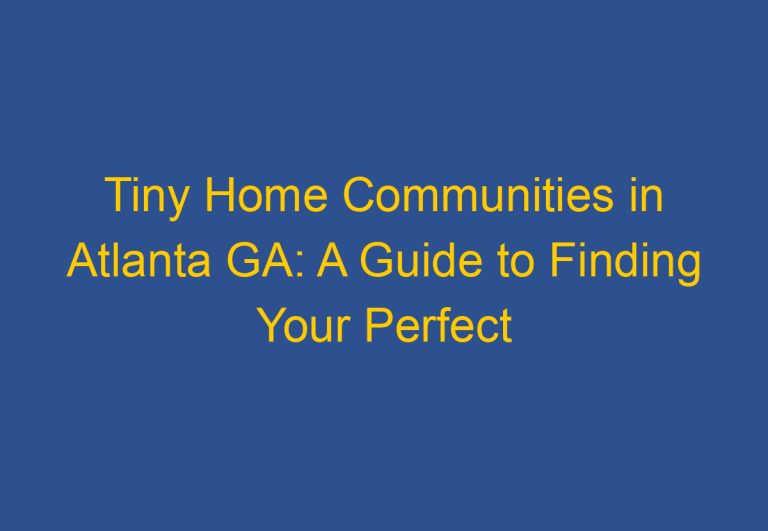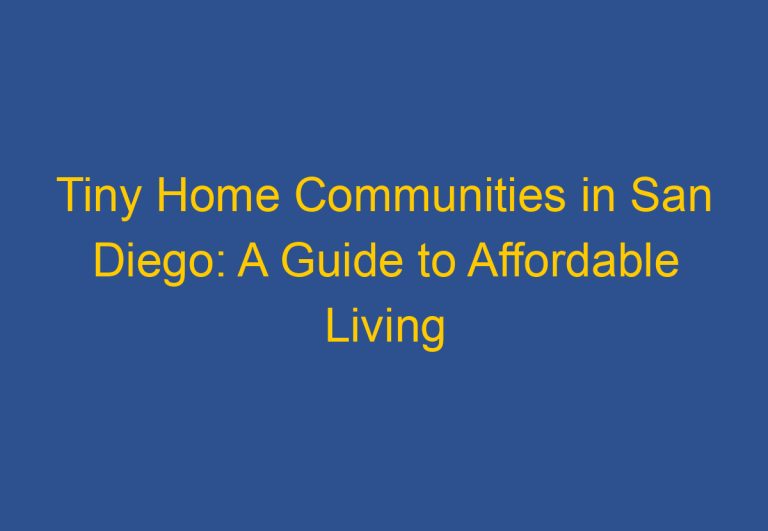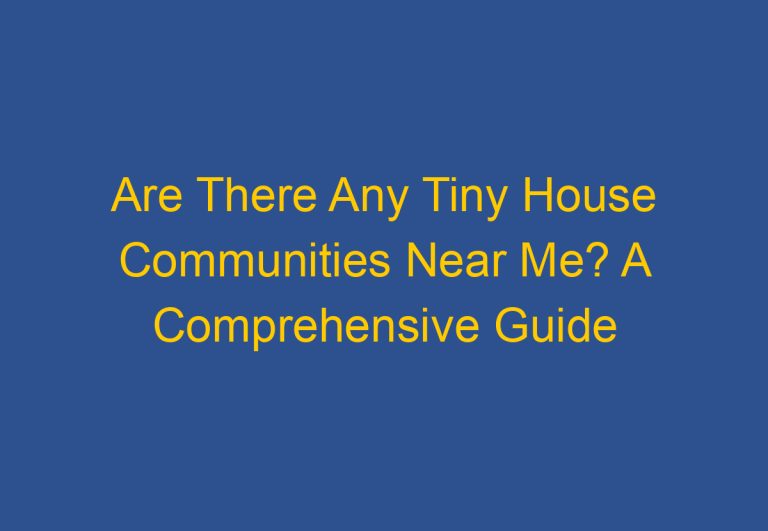How to Start a Tiny House Community: A Comprehensive Guide
Tiny house communities have become increasingly popular in recent years, especially in heavily populated areas such as larger cities. However, even smaller communities are beginning to enjoy the benefits of tiny house living. For those who live in less populated areas, creating a tiny house community may be the best option if they are unable to find an existing one to join.

Starting a tiny house community is no easy feat, but there are ways to make the process smoother. This article will explore some great ways to start a tiny house community in any area, including becoming a resource, studying and learning, networking, and making waves in the local community. By following these tips, anyone can start their own tiny house community and enjoy the benefits of this unique and sustainable way of living.
What Is a Tiny House Community?

A tiny house community is a group of like-minded individuals who share a common interest in tiny homes and living. The community can either be a physical location where tiny homes are parked in close proximity to each other, or it can be a virtual community where people share ideas and solutions.
Physical tiny house communities provide residents with a sense of belonging and support. They can share resources and amenities, such as community gardens, laundry facilities, and common areas. These communities are often built on affordable, well-located sites that comply with zoning laws and are close to amenities.
Virtual tiny house communities, on the other hand, allow people to connect and share ideas without the need to be in close proximity to each other. Members can collaborate and problem-solve together, creating a common well of knowledge that benefits everyone.
Whether physical or virtual, tiny house communities offer a unique lifestyle that is becoming increasingly popular. They provide residents with a sense of community and belonging, as well as a more affordable and sustainable way of living.
1. Become a Resource

When starting a tiny house community, it is important to understand why people seek them out. By sharing personal experiences, an individual can become a valuable resource for others looking to join the tiny house movement.
Share What You Know
One of the best ways to start a tiny house community is to be the resource that people need. This means gathering information that was personally important when starting the journey towards tiny house living. It is important to tailor this information to the specific location of the community, as zoning laws and regulations can vary greatly by region.
Individuals who have already gone through the process of starting a tiny house community are considered experts in this field. As such, they can provide valuable insight into the zoning information, permits, and design and construction aspects of tiny house living.
By sharing this knowledge with others, individuals can create a custom tiny house handbook for their town. This handbook can provide others with the information they need to prepare for tiny house living and navigate the various regulations and requirements.
It is also important to remember that the more an individual learns from others, the more their resources can change. This means being open to adapting and learning, even after going through the process of starting a tiny house community.
Overall, by becoming a resource for others, individuals can play a key role in starting and growing a successful tiny house community.
2. Study and Learn

To start a tiny house community, it is essential to study and learn about all the different aspects of the community. This includes everything from zoning and building codes to laws and guidelines. Educating oneself on how the tiny house community works is crucial to being a part of the change.
As the community continues to grow and evolve, more laws and regulations are adapting and changing to accommodate tiny house living. By staying informed and up-to-date on these changes, individuals can better advocate for their community and make a positive impact.
Having a strong community for support is also essential when it comes to making changes and improving tiny house living. However, it is crucial to have all the facts and information correct to make a real difference.
There are many resources available for those looking to start a tiny house community. Some great books to consider include “The Joy of Tiny House Living,” “Going Off the Grid,” “Tent City Urbanism,” and “Creating a Life Together.” These resources can provide valuable information on design, construction, amenities, infrastructure, utilities, and more.
In addition to books, it is also essential to research and understand local zoning and building regulations for community compliance. This includes securing all necessary permits and setting up essential utilities like water, gas, and electricity. By following these rules and regulations, individuals can ensure the success and sustainability of their tiny house community.
Overall, studying and learning about the different aspects of the tiny house community is crucial for success. By staying informed and educated, individuals can advocate for their community and make a positive impact on the world of tiny house living.
3. Networking is Key

Starting a tiny house community from scratch is no easy task, but having great connections from the start can make all the difference in the world. Networking is key to finding support, resources, and interested individuals who share your passion for the tiny house movement.
Where to Start?
One of the best ways to start networking is to find established online communities and get involved. Promote yourself as a self-starter and seek advice from those who have already built tiny house communities.
There are many established online tiny house communities that can be a great resource for networking:
- Tiny House Community
- Living Big in a Tiny House
- Tiny House Citizens
- Tiny House Talk
- Survivalist Boards
These communities offer a wealth of information and resources for those looking to start a tiny house community. Networking with other tiny house enthusiasts can lead to partnerships and collaborations that can help make your vision a reality.
In addition to online networking, attending events and conferences related to the tiny house movement can also be a great way to connect with others. These events provide opportunities to learn from experts, share ideas, and meet like-minded individuals.
Remember, networking takes time and effort, but it can be a valuable tool in building a strong and supportive community. With the right connections and resources, your tiny house community can thrive.
4. Make Waves

After establishing your tiny house community, it is time to make waves and create an impact in your local area. This section will explore some ways to make a change in your community and bring attention to your movement.
Local Community Gatherings
One of the best ways to make waves is by organizing regular gatherings in your community. These gatherings can be in the form of meetings, events, or shared meals in communal areas. By doing this, you can learn what others in the tiny house community find important and what they are passionate about.
Regular gatherings can also help you build a sense of community and establish common goals. This way, you can work together to achieve your mission and make a change in your local area.
Moreover, organizing local community gatherings can help you connect with your neighbors and other members of the community. This can be a great way to spread awareness about your tiny house community and educate others about the benefits of living in a tiny house.
In conclusion, organizing regular gatherings in your community is an essential step towards making waves and creating an impact. By doing this, you can build a strong sense of community and work together to achieve your mission.
Final Thoughts

Starting a tiny house community requires dedication, patience, and hard work. However, the benefits can be significant, both for the environment and for the people involved. By following the tips and information provided, one can create a sustainable and eco-friendly community that promotes a sense of togetherness and shared values.
One important aspect of starting a tiny house community is securing funding. There are various options available, such as crowdfunding, grants, donations, financing, investors, and loans. It is crucial to develop a solid financial plan and feasibility study to ensure the project’s success.
In addition to financial considerations, it is essential to prioritize eco-friendly and sustainable practices, such as water conservation and maintenance. By doing so, the community can reduce its carbon footprint and promote environmentally friendly living.
Ultimately, starting a tiny house community can be a rewarding experience that fosters a sense of community and promotes sustainable living. With dedication and careful planning, anyone can create an affordable housing option that benefits both the environment and the people involved.
References:

The following resources can be helpful for those interested in starting a tiny house community:
- “The Joy of Tiny House Living: Everything You Need to Know Before Taking the Plunge” is a book available on Amazon that provides valuable information on tiny house living.
- “Going Off the Grid: The How-To-Book of Simple Living and Happiness” is another book that can be useful for those seeking a simpler lifestyle.
- “Tent City Urbanism: From Self-Organized Camps to Tiny House Villages” is a book that explores the concept of tiny house villages and can be a good resource for those interested in starting a community.
- Tiny house forums such as Living Big in a Tiny House, Tiny House Citizens, and Tiny House Talk can provide a platform for discussion and information sharing.
- The Survivalist Boards forum also has a section dedicated to tiny houses and can be a helpful resource.
When starting a tiny house community, it is important to consider factors such as safety standards, internet access, rates, responsibility, workshops, lease agreements, community guidelines, community building, infrastructure development, and innovative ideas. It may be helpful to consult with real estate agents and other professionals who can provide guidance on these matters. Additionally, looking at successful existing communities such as Quixote Village and Panza can provide inspiration and ideas for creating a thriving community.
Frequently Asked Questions

What are the initial steps to establish a tiny house community?
To establish a tiny house community, one must first select an affordable and well-located site that complies with local zoning laws and is close to amenities. Afterward, it is essential to understand and follow local zoning and building regulations for community compliance. Rallying financial support through crowdfunding, partnerships, or starting a non-profit is also necessary. Finally, all necessary permits must be secured, and essential utilities like water and electricity must be set up.
What zoning laws affect the development of a tiny house community?
Zoning laws that affect the development of a tiny house community include minimum square footage requirements, setback requirements, and the definition of what constitutes a legal dwelling. These requirements vary depending on the location, so it is crucial to research and comply with local zoning laws.
How can one secure funding or grants for creating a tiny house community?
Securing funding or grants for creating a tiny house community can be done through crowdfunding, partnerships with investors, or starting a non-profit organization. Additionally, there are grants available for affordable housing and sustainable development projects that may be applicable to a tiny house community.
What are the potential returns on investment for a tiny house community?
The potential returns on investment for a tiny house community vary depending on factors such as location, demand, and the cost of construction. However, a well-designed and well-managed tiny house community can provide affordable housing options for residents and generate a steady income for investors.
How to create a sustainable and legally compliant tiny house community?
Creating a sustainable and legally compliant tiny house community requires careful planning and adherence to local zoning and building regulations. It is essential to design the community with sustainability in mind, including features such as renewable energy sources and water conservation methods. Additionally, the community must comply with all local zoning and building regulations to ensure its legality.
What are the common challenges when managing a tiny house community?
Common challenges when managing a tiny house community include maintaining community cohesion, ensuring compliance with local regulations, and managing the community’s finances. Additionally, ensuring the safety and well-being of residents and addressing any maintenance or repair issues that arise can also be challenging. However, with proper planning and management, these challenges can be overcome to create a thriving and sustainable tiny house community.






